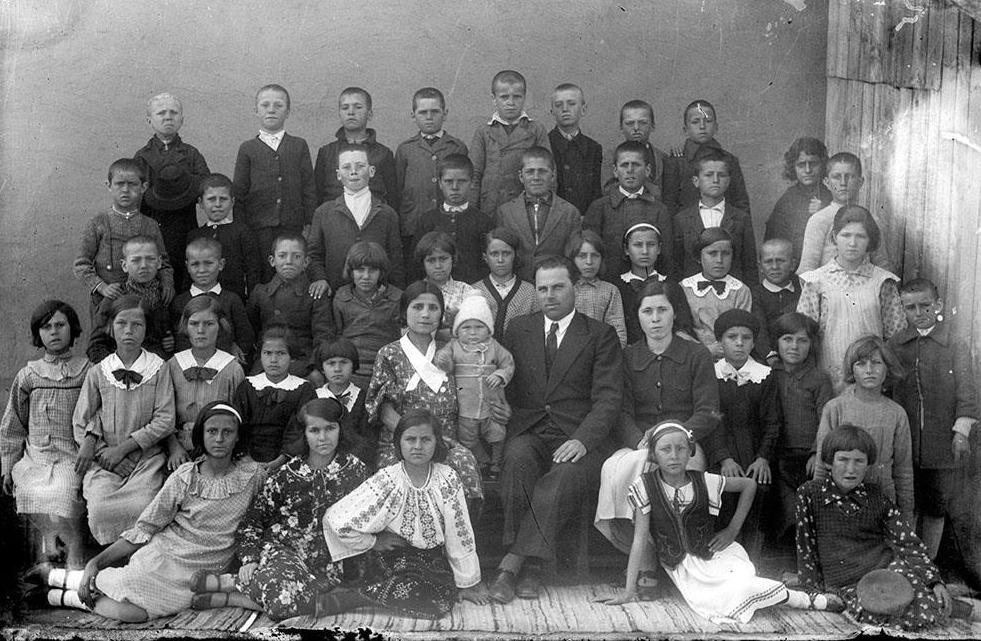
Romanian Schools: Chronology

Figure 1.--This is an unidentified Romanian primary school class we believe in the 1930s, possibly the early 30s. The children look to be about 10 years old. There are three adults in the phoyograph. We are not entirely sure who they are. e at first thought the man was the teacher. The woman at the left must be his wife with their new-born baby. We do not kniw if she had a role in the school or the man was just proud of his new baby. He would not hve needed two women to assist with his class. Perhaps he was the principal and the womsn at the right was the class teacher. The boys wear suits with close-cropped hair. It is a little hard to tell, but some of the girls may be wearing smocks. One girl wears a blouse with traditional embroidery. Another girl wears a pinafore.
|
|
HBC has not yet obtained much information on Romanian schools or schoolwear, but we have begun our assessment. We know nothing about schools diring the medieval era. Schools to the extent that they existed would have presubably been church controlled. Nor do we know anything about schools if any in Ottoman controlled areas. The Ottoman Empire did not begin to establish public schools until after they had lsrgeky been driven from the Balkans. The Romanian principalities began to establish their autonomy from the Ottoman Empire (early-19th century). We begin to see some church soponsored schools. Romania was created as a modern unified state (1866). As the Romanians could not agree on one of their own to become king, Chancellor Bismarck secured the crown for a German prince--King Carol I (1866). The German monarchy strongly influencd many aspects of Romanian life, especially the middle-class urban population. Education was one of the many areas, if not the most important institution influenced by Germany. And it is at this time that the country began to build a modern European educational system. The country built a system with high academic standards, but with limited acces for working-class children. The Communists who seized power after World War II (1945) attemoted to expand access to education. The Communists used the schools for ideological political instruction. The Communists also intensified the Romanian nationalist emphasis. The concessions to minorities were significantly reduced. Rather than allowing minorities to preserv heir culture and language, the schools were used to Romanize minority children. The largest minority was Hungarians. The Hungarian-langusge schools were merged with Romanian schools (1960s). Practically this meant that almost all of the classes taught in Hungarian were now taught in Romanian. The goal of expanding access to education was seriously comprmised but the economic failure of the Communist regime. The country was unable to finance a quality education system. Along withb the rest of Eastern Europe, the Romanian Communist regime fell (1989). Throughout Eastern Europe there proved to be no support for Communism. The Communist regimes had been kept in power by the Soviet Red Army or the thret of Red Army intervention. With the fall of Communism, Romanian authorities set about building a non-political education system. The huge damage to the Romanian economy done by the Communits meant that financing a quality education system would be difficult. The country has been slowly making progress with needed reforms.
HBC-SU

Navigate HBC Chronolgy Pages
[Late 19th century]
[The 1930s]
[The 1940s]
[The 1930s]
[The 1940s]
[The 1950s]
[The 1960s]
[The 1970s]
[The 1980s]
Related Style Pages in the Boys' Historical Web Site
[Long pants suits]
[Knicker suits]
[Short pants suits]
[Socks]
[Eton suits]
[Jacket and trousers]
[Blazer]
[School sandals]
Navigate the HBC School Section
[Return to the Main Romanian school page]
[Return to the Main European regional school page ]
[Return to the Main Romanian activities page]
[Activities]
[Chronology]
[Clothing styles]
[Countries]
[Debate]
[Economics]
[Garment]
[Gender]
[Hair]
[History]
[Home trends]
[Literary characters]
[School types]
[Significance]
[Transport and travel
[Uniform regulations]
[Year level]
[Other topics]
[Images]
[Links]
[Registration]
[Tools]
[Return to the Historic Boys' School Home]
Created: 9:48 AM 5/18/2018
Last updated: 9:48 AM 5/18/2018




